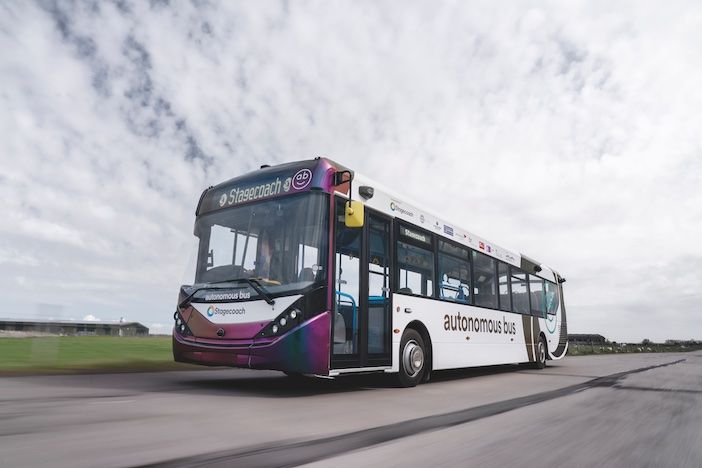After years of planning, the UK’s first fully autonomous bus service has launched in Scotland. It’s being billed as the world’s most ambitious and complex autonomous bus pilot, and could pave the way towards safer, more reliable, efficient and accessible public transportation. Lauren Dyson talks to the experts overseeing critical testing
History was made on May 15, 2023, when five passenger-carrying autonomous buses began service in Scotland. The buses belong to the £6.1m (US$7.4m) CAVForth project, which is part funded by the UK Government’s Centre for Connected and Autonomous Vehicles (CCAV). It is a significant milestone for the industry because, while we have already seen smaller trials of smaller autonomous vehicles in the UK and Europe, this is the first time a registered bus service is using full sized autonomous buses.
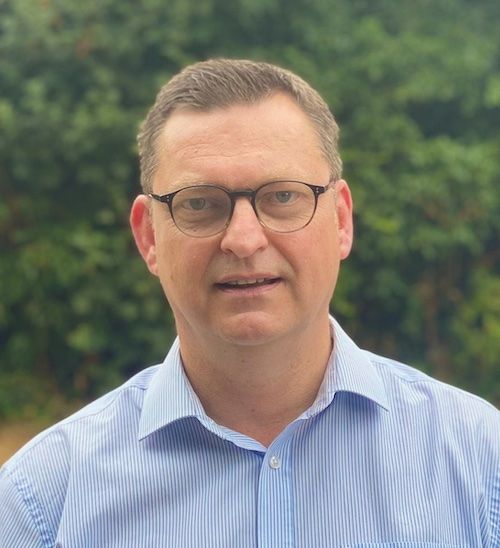
“This is a world first in terms of the capacity of paying passengers on an autonomous bus”Robert Vermeer, program manager, Innovate UK
“This is a world first in terms of capacity of paying passengers on an autonomous bus,” confirms Robert Vermeer, who is program manager at Innovate UK, which is a major funding partner for the CCAV initiative. “It’s by far the most advanced trial of this type of service to date.”
The five Alexander Dennis Enviro200AV vehicles cover a 14-mile route across the Forth Road Bridge from Ferrytoll Park & Ride in Fife to Edinburgh Park Transport Interchange. The buses travel in mixed traffic and can reach up to 50mph. The service has the capacity to transport around 10,000 passengers a week. “The trial is using a new route, which has been specifically chosen for this project after consideration with the operator,” says Vermeer.
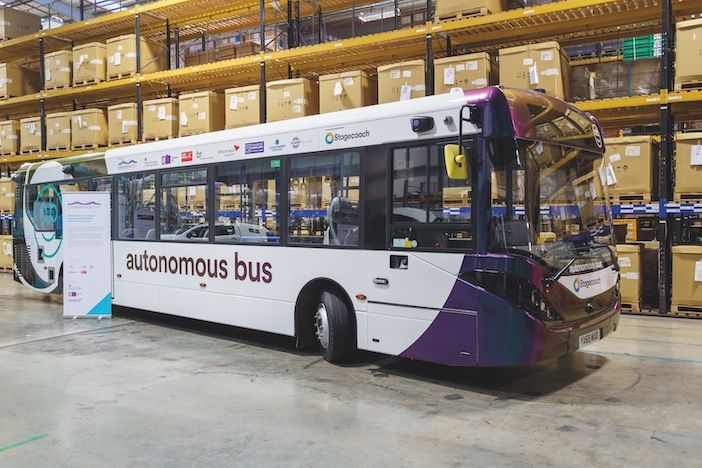
Why have an autonomous bus?
Building the CAVForth bus is a joint venture between Stagecoach, Alexander Dennis, Fusion Processing, Transport Scotland, Edinburgh Napier University and Bristol Robotics Lab. The team aims to prove that autonomous buses are a viable way to improve safety and enhance the quality of service for customers, while also reducing energy consumption and emissions.
“We have opportunities through automation and connectivity to deliver more efficient transport services,” says Mark Cracknell, program director at Zenzic, which is supporting the CAVForth project. “If you’re able to connect and communicate directly with vehicles, and if vehicles can drive in a smoother fashion, you can reduce congestion and ensure more reliable journey times, particularly on shorter journeys. That allows you to provide a greater better service to your customers.”
It is known that driving style can significantly impact fuel consumption, even among highly trained bus drivers. This variance, across a fleet of buses, can result in greater operating costs as well as increased emissions. The CAVForth team believes that its buses can yield up to a 20% fuel saving, over a manually driven vehicle. “We will be measuring the fuel economy back-to-back between manually driven buses and autonomous buses,” says Jim Fleming of Fusion Processing.
The autonomous system is designed to minimize fuel consumption, reduce wear on brakes and provide a smoother, more comfortable ride for passengers.
“Ultimately, greater efficiency and reliability results in a more cost-effective system that can be made available to more people,” says Cracknell. “But the biggest benefit that we are really driving towards is safety. We know that somewhere upwards of 86% of road accidents that occur on UK roads are attributable in some way to human error. So, if we can take out the variability of human drivers and put in a system that can be far more reliable and safer in the way it moves around the road network, we have a huge potential to reduce the number of people killed and seriously injured on our roads. We want to leverage this technology to make roads safer.”
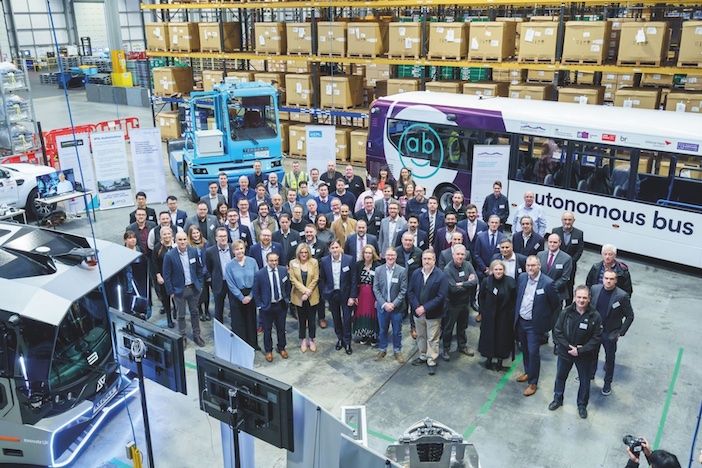
Autonomous technology
The CAVForth buses are controlled using Fusion Processing’s CAVstar automated drive system (ADS). The system comprises an AI controller and sensing system that enables the vehicle to drive autonomously within its operational design domain (ODD). The buses are designed to operate to SAE Level 4 autonomy, and they have redundancy on all safety critical systems. The buses also have two members of staff on board: a safety driver to keep an eye on the systems and a bus captain in the saloon to take tickets and answer customer questions.
“The code of practice says that you need to have a safety driver at this stage,” Vermeer explains. “Stagecoach has also provided a new type of driver training specifically for the safety drivers of these buses. Meanwhile, the bus captain understands the technology and talks to the passengers about how the bus is working and how safe it is. Passenger safety is, I would declare, 100% assured by the fact that the bus has got significant backup systems.”
The CAVstar system acts as the bus’s eyes and ears, enabling the vehicle to perceive the world around it. It can identify other road users, such as cars and cyclists, and tracks them as them as they move closer to the bus to ensure there are no collisions. To do this, it uses a series of cameras combined with lidar and radar sensors.
“The radar is for a long-ranging front view of the hazards, while the cameras and lidar provide a mid-range and short view,” says Vermeer. “All of the camera and sensor images, and data are collated and processed in real time in an artificial intelligence system. This information is then used to make instant decisions about the control systems of the vehicle. There is also a safety system, which ensures that the vehicle can’t make any movements that would be deemed unsafe. Then there’s a whole part of the system that is dedicated to route planning. This is very precise mapping that enables the vehicle to know exactly where it is and where it’s going. It knows where the bus stops are and makes sure the vehicle is in the right place at the right time.”
The first part of the project – known as CAVForth I – is ongoing and is expected to run until November 2023, during which time important data on performance, passenger experience and long-term economic viability will be collected and evaluated.
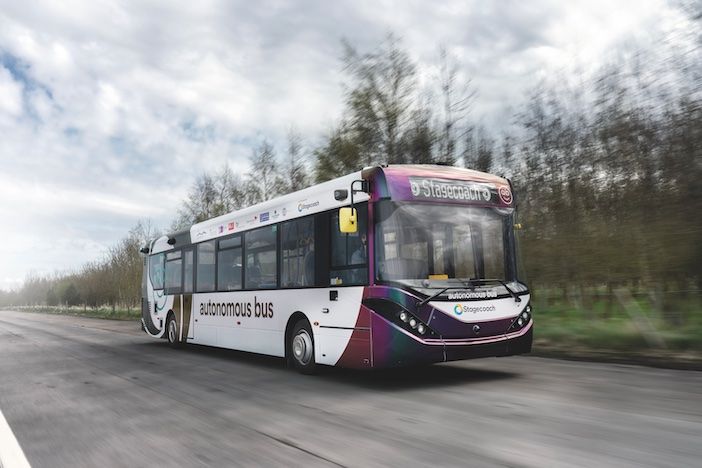
The next chapter
In February 2023, the CAVForth consortium announced that it has received funding for
the next phase of the project. Known as CAVForth II, the £10.4 million (US$13 million) expansion will see the current CAVForth route extended an additional five miles into Dunfermline city center. The additional sections of the route will involve more complex autonomous driving scenarios on busy A and B roads, as well as scenarios involving city center traffic. This phase of the project will start once phase one is complete and is scheduled to run until at least March 2025.
“CAVForth II will slightly expand the CAVForth I route a bit further on both sides of the bridge,” confirms Cracknell. “At this stage it’s also about providing a more comprehensive service. We are starting to think more about the commercial aspects of the project and what it really means to put this technology into action.”

“We need to be mindful that we remove the driver in way that is safe”
Mark Cracknell, programme director, Zenzic
CAVForth II will also see CAVstar technology fitted into a fully-electric Enviro100AEV bus from consortium partner Alexander Dennis. This bus will join the existing test fleet of five Enviro200AV diesel buses. “Although the purpose of the project isn’t necessarily to support net zero, putting an electric bus on the road instead of another diesel vehicle will inherently support a reduction in emissions,” says Vermeer.
“The most important thing about CAVForth 2 is that the consortium is challenged to commercialize the service at the end of the project,” Vermeer continues. “That’s a big challenge if they want to commercialize with profitability, because that means that they will have to remove the safety driver.” Currently, a large operational cost [around 60%] is associated with the driver of a commercial vehicle. In this project, the conventional vehicle driver will slowly, over time, be replaced by highly trained, technical fleet operators.
“We need to be mindful that we remove the safety driver at the right point, and that we do it in a way that is safe and appropriate,” says Cracknell. “There’s a lot of work to be done between now and then. Part of that is around the technology and making sure that the systems themselves are robust and we can prove that they’ve got a high level of safety. One of our core partners is a collection of testing facilities called CAM Testbed UK. Their role is to make sure that we build the testing capability we need to really put these vehicles through their paces.”
Some regulation changes will also be required. There are currently around 300 laws or pieces of legislation that are impacted by having a human as a driver. If the human driver is taken out, these 300 laws will need to be amended.
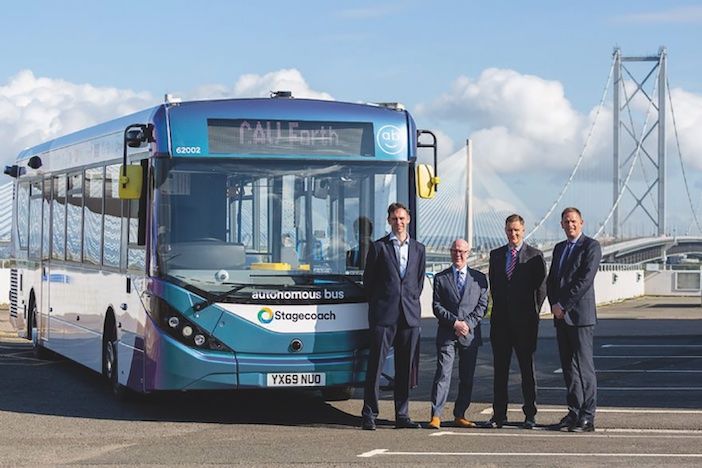
“By the time this project concludes in March 2025, we want to be in a position where the service can continue to operate,” says Cracknell. “We’re looking to support the CAVForth project in taking a step beyond the limited technology trial and starting to see how that might turn into full operation.”
“We believe that commercial vehicles are the first opportunity to commercialize autonomous vehicles,” says Fusion Processing’s Fleming. “This is because commercial vehicles operate on repeat routes and the fleet operators are intensely interested in safety, fuel efficiency and saving costs. We can bring all of that together with autonomous vehicle technology. What we hope to offer city planners and regional planners is an alternative transport system. People can walk on and walk off these vehicles in the same way they can walk on and off a train. The driver can spend more time looking after the passengers than looking after the vehicle.”
“Self-driving vehicle technology is coming and it’s clear it is going to be a huge market,” says Vermeer. “A recent independent report estimated the market will be worth around £42 billion (US$52.6 billion) in the UK by 2035. This project is high profile and because it’s with Stagecoach, an operator that everybody knows. People are using the service in Edinburgh. School children will be going to the Forth bridge to understand what the bus is doing and how it’s working. It’s going to make a big difference in terms of changing public perception of this technology.”
This feature was originally published in the September 2023 edition of TTi magazine


